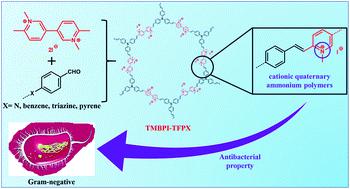当前位置:
X-MOL 学术
›
Polym. Chem.
›
论文详情
Our official English website, www.x-mol.net, welcomes your
feedback! (Note: you will need to create a separate account there.)
A metal-free approach to bipyridinium salt-based conjugated porous polymers with olefin linkages
Polymer Chemistry ( IF 4.1 ) Pub Date : 2021-2-19 , DOI: 10.1039/d0py01743d Jiawei Lin 1, 2, 3, 4 , Shuai Bi 5, 6, 7, 8, 9 , Zhongxiong Fan 1, 2, 3, 4 , Zhenzhen Fu 5, 6, 7, 8, 9 , Zhaohui Meng 1, 2, 3, 4 , Zhenqing Hou 1, 2, 3, 4 , Fan Zhang 5, 6, 7, 8, 9
Polymer Chemistry ( IF 4.1 ) Pub Date : 2021-2-19 , DOI: 10.1039/d0py01743d Jiawei Lin 1, 2, 3, 4 , Shuai Bi 5, 6, 7, 8, 9 , Zhongxiong Fan 1, 2, 3, 4 , Zhenzhen Fu 5, 6, 7, 8, 9 , Zhaohui Meng 1, 2, 3, 4 , Zhenqing Hou 1, 2, 3, 4 , Fan Zhang 5, 6, 7, 8, 9
Affiliation

|
Conjugated porous polymers are emerging as a new class of polymeric materials with substantial unique properties. Although versatile synthetic strategies have been developed, the search for a sustainable and reliable approach is still extremely desirable for achieving new polymeric species according to the demands for environmental benignity and biocompatibility. Here, we present the synthesis of a new family of olefin-linked conjugated porous polymers by the Knoevenagel condensation of a key monomer 1,1′,6,6′-tetramethyl-[3,3′-bipyridine]-1,1′-diium iodide (TMBPI) with different aryl aldehyde derivatives. In such a strategy, the methyl groups of pyridinium moieties were facile to be activated under organic base catalysis without any metal additives, and they subsequently undergo nucleophilic addition to form aldehyde groups. The resulting carbon–carbon double bond-linked porous polymers feature π-extended rigid networks, ultra-high chemical stability, and high surface areas with micro-/meso-channels, which were completely revealed by optical spectra, solid-state 13C NMR, FT-IR, thermogravimetry, XPS and nitrogen adsorption/desorption analyses. In addition, the unique highly charged skeletons of the as-prepared porous polymers make them well dispersed in some polar solvents, showing large zeta potentials (up to ζ = 16 ± 2.8 mV). Accordingly, such cationic porous polymers enable impeding bacterial growth, exhibiting good antibacterial properties against Gram-negative bacteria (e.g. E. coli).
中文翻译:

具有烯烃键联的双金属吡啶鎓盐基共轭多孔聚合物的无金属方法
共轭多孔聚合物作为具有重要独特性能的新型聚合物材料正在兴起。尽管已经开发了通用的合成策略,但是根据对环境良性和生物相容性的要求,寻求可持续和可靠的方法对于获得新的聚合物种类仍然是非常需要的。在这里,我们介绍了通过关键单体1,1',6,6'-四甲基-[3,3'-联吡啶] -1,1'的Knoevenagel缩合合成新的烯烃连接共轭多孔聚合物家族-碘化二碘(TMBPI)与不同的芳基醛衍生物。在这种策略中,吡啶鎓部分的甲基易于在有机碱催化下被活化而没有任何金属添加剂,并且它们随后进行亲核加成以形成醛基。13 C NMR,FT-IR,热重分析,XPS和氮吸附/解吸分析。此外,所制备的多孔聚合物的独特的高电荷骨架使它们很好地分散在某些极性溶剂中,显示出较大的ζ电位(高达ζ = 16±2.8 mV)。因此,这种阳离子多孔聚合物能够阻止细菌生长,对革兰氏阴性细菌(例如大肠杆菌)表现出良好的抗菌性能。
更新日期:2021-02-26
中文翻译:

具有烯烃键联的双金属吡啶鎓盐基共轭多孔聚合物的无金属方法
共轭多孔聚合物作为具有重要独特性能的新型聚合物材料正在兴起。尽管已经开发了通用的合成策略,但是根据对环境良性和生物相容性的要求,寻求可持续和可靠的方法对于获得新的聚合物种类仍然是非常需要的。在这里,我们介绍了通过关键单体1,1',6,6'-四甲基-[3,3'-联吡啶] -1,1'的Knoevenagel缩合合成新的烯烃连接共轭多孔聚合物家族-碘化二碘(TMBPI)与不同的芳基醛衍生物。在这种策略中,吡啶鎓部分的甲基易于在有机碱催化下被活化而没有任何金属添加剂,并且它们随后进行亲核加成以形成醛基。13 C NMR,FT-IR,热重分析,XPS和氮吸附/解吸分析。此外,所制备的多孔聚合物的独特的高电荷骨架使它们很好地分散在某些极性溶剂中,显示出较大的ζ电位(高达ζ = 16±2.8 mV)。因此,这种阳离子多孔聚合物能够阻止细菌生长,对革兰氏阴性细菌(例如大肠杆菌)表现出良好的抗菌性能。











































 京公网安备 11010802027423号
京公网安备 11010802027423号